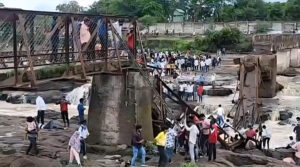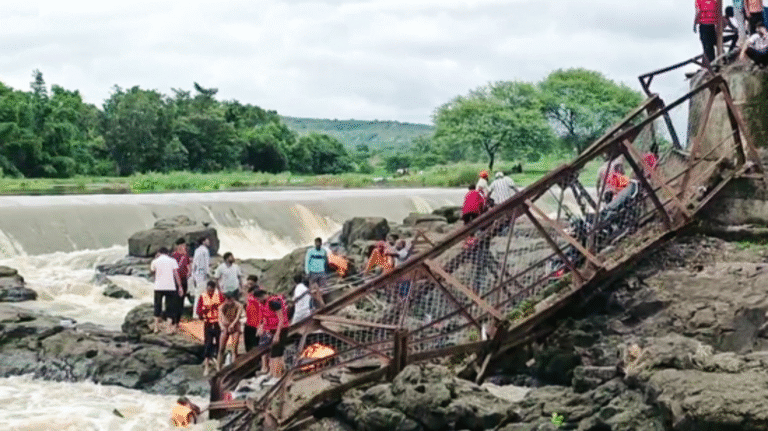Bridge Near Pune Collapsed at indrayani River
Bridge Near Pune Collapsed at indrayani River. A pedestrian bridge spanning the Indrayani River near Pune collapsed dramatically on a recent Sunday afternoon, sending shockwaves through the local community and drawing nationwide attention. The incident occurred in the Kundmala area of Dehu, a site popular among both pilgrims and tourists, especially during the monsoon season when the river swells and attracts large crowds. Eyewitnesses reported that the bridge was packed with people and motorcycles at the time of its failure, likely due to a combination of heavy foot traffic and excessive weight from vehicles. Initial reports indicate that the structure was already in poor condition, with visible signs of disrepair. When the collapse happened, many victims were thrown into the river’s strong current, making rescue efforts extremely challenging. Authorities confirmed at least two fatalities, while a significant number of individuals—estimated between 20 and 25—remain missing. Emergency response teams, including police, fire brigade, and divers, rushed to the scene, later joined by specialized disaster response units. Rescue operations are ongoing, with medical teams and ambulances stationed nearby to assist the injured. Local officials and political leaders have urged the public to exercise caution near water bodies during the monsoon and to avoid overcrowded or visibly unsafe infrastructure.

This tragedy is far from isolated in India’s recent history. Bridge collapses have become a recurring problem, often linked to aging structures, poor maintenance, and inadequate oversight. One of the most catastrophic incidents in recent memory occurred in Morbi, Gujarat, in October 2022, when a historic suspension bridge collapsed just days after reopening to the public. That disaster resulted in more than 140 fatalities and left over 180 people injured, with a large proportion of the victims being women, children, and the elderly. The bridge, originally built during the British era and recently refurbished, was reportedly overcrowded at the time of collapse, far exceeding its intended capacity. The aftermath of the Morbi tragedy led to widespread outrage and calls for stricter safety regulations and accountability for those responsible for bridge maintenance.
Other notable bridge collapses have occurred across different regions of India. In Bihar, a series of incidents in recent years has highlighted systemic issues with construction quality and maintenance. For example, a bridge in the Sattarghat area collapsed within a month of its inauguration after heavy rains and strong river currents, raising serious questions about the standards of engineering and oversight. In another case, parts of an under-construction bridge in Bhagalpur district collapsed twice within a short period, further underscoring the dangers of poor construction practices. In the first week of July 2024 alone, three bridges in Bihar’s Saran district collapsed within hours of each other, prompting the state government to order a survey of all old bridges for urgent repairs.
In West Bengal, the 2011 Darjeeling bridge collapse claimed the lives of 32 people and injured more than 60 when an old wooden footbridge gave way during a political gathering. That same year, a footbridge in Arunachal Pradesh collapsed while people were crossing to collect insects, resulting in at least 30 deaths, mostly children. In 2016, a British-era bridge on the Mumbai-Goa highway over the Savitri River collapsed, killing 29 people. Also in 2016, an under-construction flyover in Kolkata collapsed, leading to 26 deaths and over 60 injuries. In 2018, a portion of the Majerhat flyover in Kolkata collapsed, resulting in three deaths and 24 injuries. In 2019, a foot overbridge near a major railway station in Mumbai collapsed, killing six and injuring more than 30.
A comprehensive study analyzing bridge failures in India between 1977 and 2017 found that more than 2,000 bridges collapsed or failed to provide their intended service during that period. Natural disasters, such as floods and earthquakes, were responsible for over 80% of these failures, highlighting the vulnerability of India’s infrastructure to environmental factors. Other significant causes included material deterioration, overloading, and, in rare cases, accidents involving vehicles or ships. The study’s findings underscore the urgent need for regular inspections, robust maintenance programs, and improved engineering standards to prevent future tragedies.
The recurring theme in these incidents is the combination of aging infrastructure, inadequate maintenance, and insufficient enforcement of safety regulations. While the number of bridge collapses has shown a declining trend in some regions, the potential for catastrophic loss remains high, particularly during the monsoon season when rivers are swollen and structures are put under additional stress. The recent Pune bridge collapse serves as a stark reminder of the ongoing challenges facing India’s infrastructure and the urgent need for sustained investment in maintenance, stricter safety protocols, and greater public awareness to prevent further loss of life.
Key Points Highlighted Throughout:
Pune Bridge Collapse (June 2025): Collapse of a pedestrian bridge over the Indrayani River during heavy tourist rush; at least two dead, many missing; ongoing rescue operations; bridge was in poor condition and overloaded.
Morbi, Gujarat (2022): Historic suspension bridge collapse shortly after reopening; over 140 dead, more than 180 injured; bridge was overcrowded and recently refurbished.
Bihar Incidents: Multiple bridge collapses in recent years, including Sattarghat (collapsed within a month of inauguration) and Bhagalpur (under-construction bridge collapsed twice); series of collapses in July 2024 led to government survey of old bridges.
West Bengal and Other Regions: Darjeeling (2011) – 32 dead, over 60 injured; Arunachal Pradesh (2011) – at least 30 dead, mostly children; Mumbai-Goa highway (2016) – 29 dead; Kolkata (2016, 2018, 2019) – multiple incidents with significant casualties.
Root Causes: Aging infrastructure, poor maintenance, overloading, natural disasters, and inadequate oversight.
Statistics: Over 2,000 bridge failures reported from 1977 to 2017; natural disasters accounted for over 80% of failures; urgent need for regular inspections and maintenance.


1 thought on “Bridge Near Pune Collapsed at indrayani River”